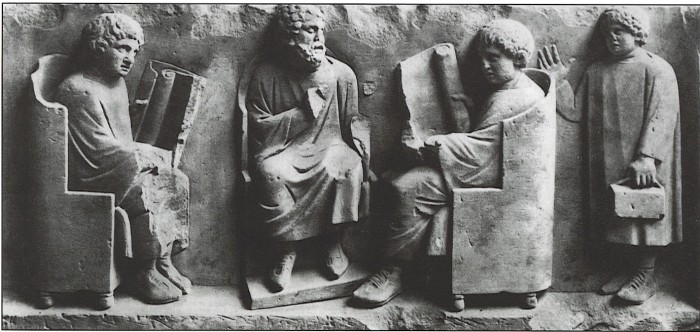Our ancient schoolroom costumes are modelled after the ones worn by both children and teacher in this relief:
The main garment is a tunic (tunica), not a toga; in Roman times togas were worn only by aristocratic men and primarily for formal occasions, whereas tunics were the ordinary garments of ordinary people. Our tunics are made of pure cotton; although Romans in Italy and Britain tended to make their clothes out of wool or linen, cotton was used in Egypt, where the schoolroom is set. (Admittedly Egyptian tunics were a bit skimpier than the ones we used as models; the relief above comes from Trier in Germany, which is much colder than Egypt, and the tunics it shows were probably made of wool.) Our tunics are designed to be worn on top of participants’ regular clothing and can usually hide that clothing effectively, though people wearing long trousers may need to roll them up and everyone will probably want to remove jackets and jumpers to avoid overheating. The fabric of our tunics is simply woven as in antiquity, when knitting and other ways of making cloth stretchy had not yet been invented. This means that the tunics cannot stretch and may rip if treated like modern clothes – so please be gentle with them! The blue, yellow, white, and greenish-brown tunics were handmade by schoolroom volunteers; the red ones come from the Roman Shop. And yes, we do wash them regularly; they are much cleaner than is strictly authentic, though we are pleased by the very authentic accumulation of ink stains.
Our shoes are replicas of a Roman shoe type called carbatinae, which were in use for many centuries of the Roman period; like the tunics, they reflect ordinary rather than fancy dress. Each is handmade from a single piece of organic leather tanned with vegetable derivatives in ancient fashion and sewn together with leather thongs that also serve as laces. The shoes all come from the Roman Shop. They are fragile compared to modern footwear, so again, please be gentle with them: we spend a lot of time repairing the shoes. For hygiene reasons we ask participants to wear their own socks with the shoes.
Our vittae (hair ribbons) are an accessory often worn by Roman freeborn girls and matrons; one authentic way to wear a vitta is to tie it around the head with a small bow at the back, leaving long ends trailing down one’s neck (see Smith’s Dictionary). But Roman hairstyles were nearly as diverse as modern ones, so there are many other authentic possibilities – and you can also use a vitta to conceal a modern elastic hairband. In Roman times boys did not wear vittae, but we overlook this point in the interests of equality. And gloriously, our vittae are not particularly fragile and do not need special gentleness.



